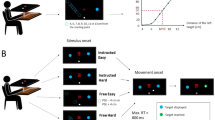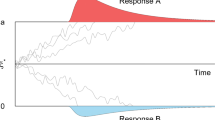Abstract
Schizophrenia patients tend to have longer and more variable latencies of response than healthy control subjects. However, the distributions of data from the two groups overlap to a large extent. Therefore, we investigated (1) whether the process of response selection in schizophrenia patients is like that of slow control subjects or has different properties, and (2) whether the intra-individual variability of schizophrenia patients is intrinsically greater than that of control subjects or reflects their longer mean latency. To answer these questions we tested schizophrenia patients and healthy control subjects in a choice reaction time (RT) task with 2-choice and 4-choice conditions. We analyzed how mean RT in the 2-choice condition predicted mean RT in the 4-choice condition and found that the relation was significantly different between the two groups. In contrast, the intra-individual variability of RT was related to mean RT in the same way for schizophrenia patients and control subjects. These results indicate that the response selection process of schizophrenia patients was not simply a slower version of the same process engaged by control subjects, but it was a selection process with different dynamic properties. In contrast, schizophrenia patients did not have a greater intrinsic variability than control subjects. Furthermore, we found that the difference Δt between RT measured in the 4-choice condition and RT predicted for the control group in the same condition could be used to discriminate effectively patients and control subjects. However, there was no significant association between Δt and clinical variables. These results suggest that Δt could reflect a trait impairment of schizophrenia independent from symptom profile. Finally, we suggest that the impairment of the process of selection of the motor response in schizophrenia reflects the alteration of the time-dependent patterns of neural activity that result from anomalies in the connectivity of the brain areas engaged for the selection of the motor response.



Similar content being viewed by others
References
Andreasen NC (1983) Scale for the assessment of negative symptoms (SANS). University of Iowa Press, Iowa City
Andreasen NC (1984) Scale for the assessment of positive symptoms (SAPS). University of Iowa Press, Iowa City
Andreasen NC, Arndt S, Alliger R, Miller D, Flaum M (1995) Symptoms of schizophrenia. Methods, meanings, and mechanisms. Arch Gen Psychiatry 52:341–351
Andreasen NC, Paradiso S, O’Leary DS (1998) ‘Cognitive dysmetria’ as an integrative theory of schizophrenia: a dysfunction in cortical-subcortical-cerebellar circuitry? Schizophr Bull 24:203–218
Basso MA, Wurtz RH (1997) Modulation of neuronal activity by target uncertainty. Nature 389:66–69
Braff DL (1993) Information processing and attention dysfunctions in schizophrenia. Schizophr Bull 19:233–259
Bredgaard R, Glenthøj BY (2000) Information processing and attentional dysfunctions as vulnerability indicators in schizophrenia spectrum disorders. World J Biol Psychiatry 1:5–15
Cadenhead KS, Geyer MA, Butler W, Perry W, Sprock J, Braff DL (1997) Information processing deficits of schizophrenia patients: relationship to clinical ratings, gender and medication status. Schizophr Res 28:51–62
Cannon TD, Huttunen MO, Lonnqvist J, Tuulio-Henrikson A, Pirkola T, Glahn D, Finkelstein J, Hietanen M, Kaprio J, Koskenvuo M (2000) The inheritance of neuropsychological dysfunction in twins discordant for schizophrenia. Am J Hum Genet 67:369–382
Cavina-Pratesi C, Valyear KF, Culham JC, Köhler S, Obhi S, Marzi CA, Goodale M (2006) Dissociating arbitrary stimulus-response mapping from movement planning during preparatory period; evidence from event-related functional magnetic resonance imaging. J Neurosci 26:2704–2713
Crawford JR, Besson JA, Bremner M, Ebmeier KP, Cochrane RH, Kirkwood K (1992) Estimation of premorbid intelligence in schizophrenia. Br J Psychiatry 161:69–74
Dassonville P, Lewis SM, Zhu X-H, Ugurbil K, Kim SG, Ashe J (2001) The effect of stimulus-response compatibility on cortical motor activation. Neuroimage 13:1–14
Erlhagen W, Schöner G (2002) Dynamic field theory of movement preparation. Psychol Rev 109:545–572
First MB, Spitzer RL, Gibbon M, Williams JBW (2002) Structured clinical interview for DSM-IV-TR Axis I Disorders, Research Version, Patient Edition. (SCID-I/P). Biometrics Research, New York State Psychiatric Institute, New York
Fleck DE, Sax KW, Strakowski MS (2001) Reaction time measures of sustained attention differentiate bipolar disorder from schizophrenia. Schizophr Res 52:251–259
Friston KJ (1998) The disconnection hypothesis. Schizophr Res 30:115–125
Fuller RL, Luck SJ, Braun EL, Robinson BM, McMahon RP, Gold JM (2006) Impaired control of visual attention in schizophrenia. J Abnorm Psychol 115:266–275
Gale HJ, Holzman PS (2000) A new look at reaction time in schizophrenia. Schizophr Res 46:149–165
Goldberg TE, Gold JM (1995) Neurocognitive functioning in patients with schizophrenia. An overview. In: Bloom FE, Kupfer DJ (eds) Psychopharmacology—The fourth generation of progress. Raven Press, New York, pp 1245–1257
Hemsley DR (1976) Attention and information processing in schizophrenia. Br J Soc Clin Psychol 15:199–209
Hosmer DW, Lemeshow S (2000) Applied logistic regression, 2nd edn. Wiley, New York
Kanaan RAA, Kim J-S, Kaufmann WE, Pearlson GD, Barker GJ, McGuire PK (2005) Diffusion tensor imaging in schizophrenia. Biol Psychiatry 58:921–929
Krieger S, Lis S, Cetin T, Gallhofer B, Meyer-Lindenberg A (2005) Executive function and cognitive subprocesses in first-episode, drug-naïve schizophrenia: an analysis of N-back performance. Am J Psychiatry 162:1206–1208
Kubicki M, McCarley R, Westin CF, Park HJ, Maier S, Kikinis R, Jolesz FA, Shenton ME (2007) A review of diffusion tensor imaging studies in schizophrenia. J Psychiatr Res 41:15–30
Laurent A, Biloa-Tang M, Bougerol T, Duly D, Anchisi AM, Bosson JL, Pellat J, d’Amato T, Dalery J (2000) Executive/attentional performance and measures of schizotypy in patients with schizophrenia and in their nonpsychotic first-degree relatives. Schizophr Res 46:269–283
Lee D (2006) Neural basis of quasi-rational decision making. Curr Opin Neurobiol 16:191–198
Luce RD (1986) Response times. Their role in inferring elementary mental organization. Oxford Science Publications, New York
Madden DJ, Whiting WL, Huettel SA, White LE, MacFall JR, Provenzale JM (2004) Diffusion tensor imaging of adult age differences in cerebral white matter: relation to response time. Neuroimage 21:1174–1181
Malla AK, Norman RM, Aguilar O, Carnahan H, Cortese L (1995) Relationship between movement planning and psychopathology profiles in schizophrenia. Br J Psychiatry 167:211–215
Milner AD (1986) Chronometric analysis in neuropsychology. Neuropsychologia 24:115–128
Nelson HE, Willison JR (1991) National adult reading test, 2nd edn. NFER-Nelson, Windsor
Ngan ET, Liddle PF (2000) Reaction time, symptom profiles and course of illness in schizophrenia. Schizophr Res 46:195–201
Nuechterlein KH (1977) Reaction time and attention in schizophrenia: a critical evaluation of the data and theories. Schizophr Bull 3:373–428
Overall JE, Gorham DR (1962) The brief psychiatric rating scale. Psychol Rep 10:799–812
Pellizzer G, Georgopoulos AP (1993) Common processing constraints for visuomotor and visual mental rotations. Exp Brain Res 93:165–172
Pellizzer G, Hedges JH (2003) Motor planning: effect of directional uncertainty with discrete spatial cues. Exp Brain Res 150:276–289
Pellizzer G, Hedges JH (2004) Motor planning: effect of directional uncertainty with continuous spatial cues. Exp Brain Res 154:121–126
Posada A, Franck N (2002) Use and automation of a rule in schizophrenia. Psychiatry Res 109:289–296
Ratcliff R (1993) Methods for dealing with reaction time outliers. Psychol Bull 114:510–532
Schatz J (1998) Cognitive processing efficiency in schizophrenia: generalized vs domain specific deficits. Schizophr Res 30:41–49
Schreiber H, Stolz-Born G, Heinrich H, Kornhuber HH, Born J (1992) Attention, cognition, and motor perseveration in adolescents at genetic risk for schizophrenia and control subjects. Psychiatry Res 44:125–140
Schumacher EH, Elston PA, D’Esposito M (2003) Neural evidence for representation-specific response selection. J Cogn Neurosci 15:1111–1121
Schwartz F, Carr AC, Munich RL, Glauber S, Lesser B, Murray J (1989) Reaction time impairment in schizophrenia and affective illness: the role of attention. Biol Psychiatry 25:540–548
Schwartz F, Munich RL, Carr A, Bartuch E, Lesser B, Rescigno D, Viegener B (1991) Negative symptoms and reaction time in schizophrenia. J Psychiatr Res 25:131–140
Seidman LJ, Van Manen KJ, Turner WM, Gamser DM, Faraone SV, Goldstein JM, Tsuang MT (1998) The effect of increasing resource demand on vigilance in adults with schizophrenia or developmental attentional/learning disorders: a preliminary study. Schizophr Res 34:101–112
Shakow D (1963) Psychological deficit in schizophrenia. Behav Sci 4:275–305
Snedecor GW, Cochran WG (1989) Statistical methods, 8th edn. Iowa State University Press, Ames
Tuch DS, Salat DH, Wisco JJ, Zaleta AK, Hevelone ND, Rosas D (2005) Choice reaction time performance correlates with diffusion anisotropy in white matter pathways supporting visuospatial attention. Proc Natl Acad Sci USA 102:12212–12217
Van Kammen D, Marder S (1995) Dopamine receptor antagonists. In: Kaplan H, Sadock B (eds) Comprehensive text book of psychiatry. Williams & Wilkins, Baltimore, pp 1987–2022
Vinogradov S, Poole JH, Willis-Shore J, Ober BA, Shenaut GK (1998) Slower and more variable reaction times in schizophrenia: what do they signify? Schizophr Res 32:183–190
Walker E, Shaye J (1982) Familial schizophrenia. A predictor of neuromotor and attentional abnormalities in schizophrenia. Arch Gen Psychiatry 39:1153–1156
Woods SW (2003) Chlorpromazine equivalent doses for the newer atypical antipsychotics. J Clin Psychiatry 64:663–667
Acknowledgments
This research was supported in part by a Medical Research Service Merit Review Award from the Office of Research and Development of the US Department of Veterans Affairs (G.P.), by an Advanced Research Career Development Award from the US Department of Veterans Affairs (M.S.) and by a Grant-in-Aid from the University of Minnesota (M.S. and G.P.). The authors thank Kate McClannahan for participating in the collection of data.
Author information
Authors and Affiliations
Corresponding author
Rights and permissions
About this article
Cite this article
Pellizzer, G., Stephane, M. Response selection in schizophrenia. Exp Brain Res 180, 705–714 (2007). https://doi.org/10.1007/s00221-007-0892-5
Received:
Accepted:
Published:
Issue Date:
DOI: https://doi.org/10.1007/s00221-007-0892-5




